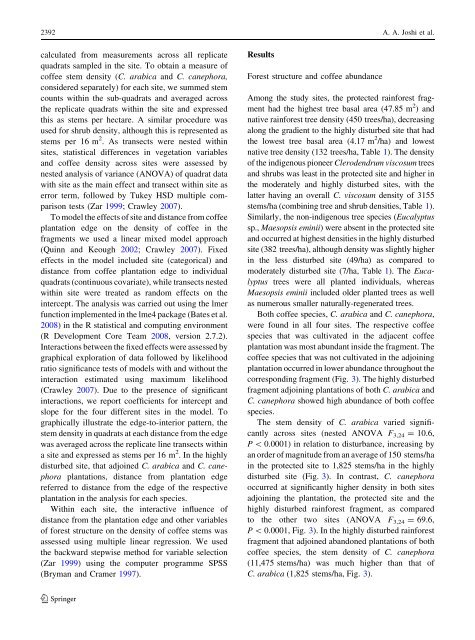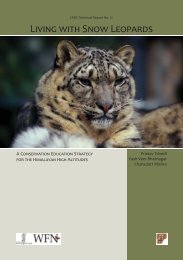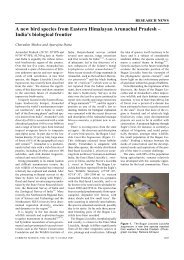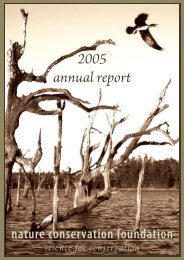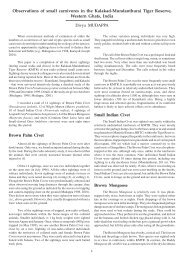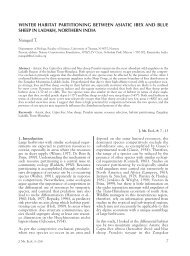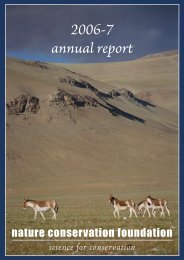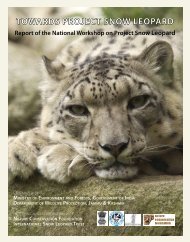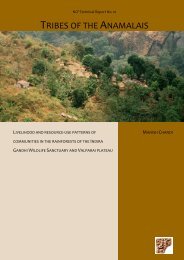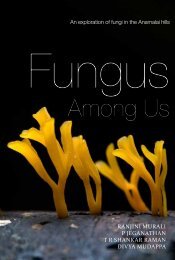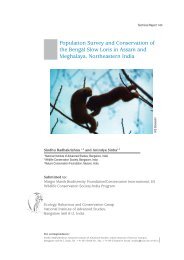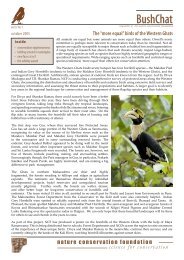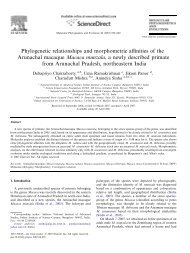Joshi Mudappa Raman - Nature Conservation Foundation
Joshi Mudappa Raman - Nature Conservation Foundation
Joshi Mudappa Raman - Nature Conservation Foundation
You also want an ePaper? Increase the reach of your titles
YUMPU automatically turns print PDFs into web optimized ePapers that Google loves.
2392 A. A. <strong>Joshi</strong> et al.<br />
calculated from measurements across all replicate<br />
quadrats sampled in the site. To obtain a measure of<br />
coffee stem density (C. arabica and C. canephora,<br />
considered separately) for each site, we summed stem<br />
counts within the sub-quadrats and averaged across<br />
the replicate quadrats within the site and expressed<br />
this as stems per hectare. A similar procedure was<br />
used for shrub density, although this is represented as<br />
stems per 16 m 2 . As transects were nested within<br />
sites, statistical differences in vegetation variables<br />
and coffee density across sites were assessed by<br />
nested analysis of variance (ANOVA) of quadrat data<br />
with site as the main effect and transect within site as<br />
error term, followed by Tukey HSD multiple comparison<br />
tests (Zar 1999; Crawley 2007).<br />
To model the effects of site and distance from coffee<br />
plantation edge on the density of coffee in the<br />
fragments we used a linear mixed model approach<br />
(Quinn and Keough 2002; Crawley 2007). Fixed<br />
effects in the model included site (categorical) and<br />
distance from coffee plantation edge to individual<br />
quadrats (continuous covariate), while transects nested<br />
within site were treated as random effects on the<br />
intercept. The analysis was carried out using the lmer<br />
function implemented in the lme4 package (Bates et al.<br />
2008) in the R statistical and computing environment<br />
(R Development Core Team 2008, version 2.7.2).<br />
Interactions between the fixed effects were assessed by<br />
graphical exploration of data followed by likelihood<br />
ratio significance tests of models with and without the<br />
interaction estimated using maximum likelihood<br />
(Crawley 2007). Due to the presence of significant<br />
interactions, we report coefficients for intercept and<br />
slope for the four different sites in the model. To<br />
graphically illustrate the edge-to-interior pattern, the<br />
stem density in quadrats at each distance from the edge<br />
was averaged across the replicate line transects within<br />
a site and expressed as stems per 16 m 2 . In the highly<br />
disturbed site, that adjoined C. arabica and C. canephora<br />
plantations, distance from plantation edge<br />
referred to distance from the edge of the respective<br />
plantation in the analysis for each species.<br />
Within each site, the interactive influence of<br />
distance from the plantation edge and other variables<br />
of forest structure on the density of coffee stems was<br />
assessed using multiple linear regression. We used<br />
the backward stepwise method for variable selection<br />
(Zar 1999) using the computer programme SPSS<br />
(Bryman and Cramer 1997).<br />
123<br />
Results<br />
Forest structure and coffee abundance<br />
Among the study sites, the protected rainforest fragment<br />
had the highest tree basal area (47.85 m 2 )and<br />
native rainforest tree density (450 trees/ha), decreasing<br />
along the gradient to the highly disturbed site that had<br />
the lowest tree basal area (4.17 m 2 /ha) and lowest<br />
native tree density (132 trees/ha, Table 1). The density<br />
of the indigenous pioneer Clerodendrum viscosum trees<br />
and shrubs was least in the protected site and higher in<br />
the moderately and highly disturbed sites, with the<br />
latter having an overall C. viscosum density of 3155<br />
stems/ha (combining tree and shrub densities, Table 1).<br />
Similarly, the non-indigenous tree species (Eucalyptus<br />
sp., Maesopsis eminii) were absent in the protected site<br />
and occurred at highest densities in the highly disturbed<br />
site (382 trees/ha), although density was slightly higher<br />
in the less disturbed site (49/ha) as compared to<br />
moderately disturbed site (7/ha, Table 1). The Eucalyptus<br />
trees were all planted individuals, whereas<br />
Maesopsis eminii included older planted trees as well<br />
as numerous smaller naturally-regenerated trees.<br />
Both coffee species, C. arabica and C. canephora,<br />
were found in all four sites. The respective coffee<br />
species that was cultivated in the adjacent coffee<br />
plantation was most abundant inside the fragment. The<br />
coffee species that was not cultivated in the adjoining<br />
plantation occurred in lower abundance throughout the<br />
corresponding fragment (Fig. 3). The highly disturbed<br />
fragment adjoining plantations of both C. arabica and<br />
C. canephora showed high abundance of both coffee<br />
species.<br />
The stem density of C. arabica varied significantly<br />
across sites (nested ANOVA F3,24 = 10.6,<br />
P \ 0.0001) in relation to disturbance, increasing by<br />
an order of magnitude from an average of 150 stems/ha<br />
in the protected site to 1,825 stems/ha in the highly<br />
disturbed site (Fig. 3). In contrast, C. canephora<br />
occurred at significantly higher density in both sites<br />
adjoining the plantation, the protected site and the<br />
highly disturbed rainforest fragment, as compared<br />
to the other two sites (ANOVA F3,24 = 69.6,<br />
P \ 0.0001, Fig. 3). In the highly disturbed rainforest<br />
fragment that adjoined abandoned plantations of both<br />
coffee species, the stem density of C. canephora<br />
(11,475 stems/ha) was much higher than that of<br />
C. arabica (1,825 stems/ha, Fig. 3).


